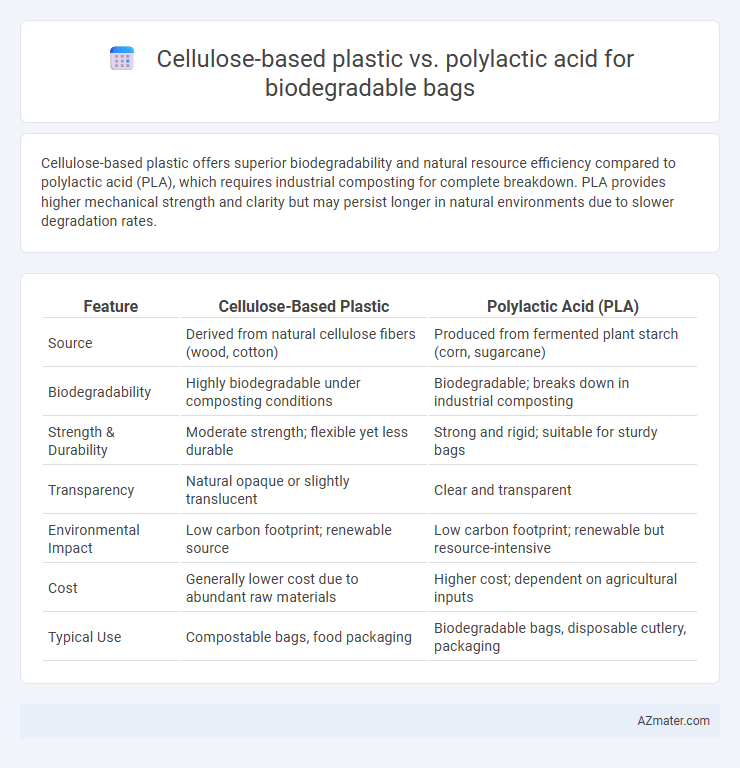Cellulose-based plastic offers superior biodegradability and natural resource efficiency compared to polylactic acid (PLA), which requires industrial composting for complete breakdown. PLA provides higher mechanical strength and clarity but may persist longer in natural environments due to slower degradation rates.
Table of Comparison
| Feature | Cellulose-Based Plastic | Polylactic Acid (PLA) |
|---|---|---|
| Source | Derived from natural cellulose fibers (wood, cotton) | Produced from fermented plant starch (corn, sugarcane) |
| Biodegradability | Highly biodegradable under composting conditions | Biodegradable; breaks down in industrial composting |
| Strength & Durability | Moderate strength; flexible yet less durable | Strong and rigid; suitable for sturdy bags |
| Transparency | Natural opaque or slightly translucent | Clear and transparent |
| Environmental Impact | Low carbon footprint; renewable source | Low carbon footprint; renewable but resource-intensive |
| Cost | Generally lower cost due to abundant raw materials | Higher cost; dependent on agricultural inputs |
| Typical Use | Compostable bags, food packaging | Biodegradable bags, disposable cutlery, packaging |
Introduction to Biodegradable Bags
Biodegradable bags made from cellulose-based plastic utilize natural plant fibers, offering excellent compostability and reduced environmental toxicity compared to conventional plastics. Polylactic acid (PLA), derived from fermented plant starch like corn or sugarcane, provides strong tensile strength and a lower carbon footprint during production. Both materials support sustainable waste management by decomposing faster in industrial composting facilities, minimizing plastic pollution and promoting circular economy principles.
Overview of Cellulose-Based Plastics
Cellulose-based plastics are derived from natural cellulose fibers extracted primarily from wood pulp and cotton, offering a renewable, biodegradable alternative to petroleum-based plastics. These bioplastics exhibit excellent mechanical strength, compostability under industrial conditions, and reduced carbon footprint compared to conventional plastics. Their compatibility with existing plastic processing technologies and non-toxic degradation products make cellulose-based plastics a sustainable choice for biodegradable bags in various applications.
What is Polylactic Acid (PLA)?
Polylactic acid (PLA) is a biodegradable thermoplastic derived from renewable resources such as corn starch or sugarcane, widely used in the production of eco-friendly bags. Unlike cellulose-based plastics, PLA offers superior clarity and processability, making it a popular choice for biodegradable packaging. PLA decomposes into natural compounds like water and carbon dioxide under industrial composting conditions, reducing environmental impact compared to traditional petroleum-based plastics.
Raw Materials and Sourcing
Cellulose-based plastic is derived from abundant natural fibers such as wood pulp and agricultural residues, offering a renewable source with widespread availability and lower land use impact compared to food crops. Polylactic acid (PLA) is produced from fermenting sugars found in corn, sugarcane, or other starch-rich plants, often raising concerns over competition with food supply and resource-intensive agriculture. Sustainable sourcing for cellulose film relies on certified forestry and agricultural waste, while PLA requires careful management of crop inputs and land use to minimize ecological footprint.
Biodegradability and Decomposition Rates
Cellulose-based plastic biodegrades rapidly due to its natural polymer structure, typically decomposing within weeks to months in industrial composting environments, making it highly efficient for short-term waste management. Polylactic acid (PLA) requires specific conditions such as high temperature and humidity found in industrial composters to biodegrade effectively, often taking several months to over a year. The faster decomposition rate of cellulose-based plastics offers a more environmentally sustainable choice for biodegradable bags where quick biodegradability is a priority.
Environmental Impact Comparison
Cellulose-based plastics exhibit superior biodegradability due to their natural plant fiber composition, breaking down efficiently in soil and marine environments without releasing toxic residues. Polylactic acid (PLA), derived from corn starch or sugarcane, biodegrades primarily in industrial composting facilities under controlled temperature and humidity, limiting its breakdown in natural settings. Life cycle assessments reveal that cellulose-based plastics generally have lower greenhouse gas emissions and reduced reliance on agricultural inputs compared to PLA, making them a more environmentally sustainable option for biodegradable bags.
Mechanical Strength and Durability
Cellulose-based plastics exhibit higher mechanical strength and enhanced durability compared to polylactic acid (PLA), making them more suitable for heavy-duty biodegradable bags. PLA tends to have lower tensile strength and is more prone to brittleness under physical stress, limiting its durability in long-term or load-bearing applications. The fibrous structure of cellulose polymers contributes to improved toughness and resistance to tearing, essential for robust biodegradable packaging solutions.
Manufacturing Processes and Costs
Cellulose-based plastics are derived from natural fibers like wood pulp and typically involve chemical modification processes such as esterification or etherification, which can increase production complexity and costs. Polylactic acid (PLA), produced through fermentation of renewable resources like corn starch followed by polymerization, benefits from well-established industrial-scale manufacturing, often resulting in lower and more consistent costs. While cellulose-based plastics may offer superior biodegradability, PLA's streamlined production process and availability of feedstock contribute to its competitive pricing in biodegradable bag manufacturing.
Application Suitability for Everyday Use
Cellulose-based plastic offers excellent moisture resistance and strength, making it ideal for grocery bags and food packaging where durability and biodegradability are crucial. Polylactic acid (PLA) provides superior transparency and compostability, suitable for lightweight applications such as produce bags and disposable liners. Both materials degrade under industrial composting conditions, but cellulose-based plastics tend to perform better in varied environmental conditions for everyday use.
Future Prospects and Innovations
Cellulose-based plastics, derived from abundant natural fibers, offer promising future prospects due to their excellent biodegradability and compatibility with existing recycling systems, making them highly attractive for sustainable bag production. Innovations in nanocellulose technology are enhancing the mechanical strength and barrier properties of cellulose-based plastics, potentially expanding their applications in packaging. Polylactic acid (PLA) continues to advance with genetic engineering of feedstock crops and improved fermentation processes, leading to reduced production costs and increased biodegradability under industrial composting conditions, securing its role in the biodegradable bag market.

Infographic: Cellulose-based plastic vs Polylactic acid for Biodegradable bag
 azmater.com
azmater.com